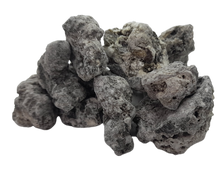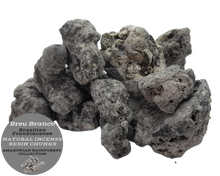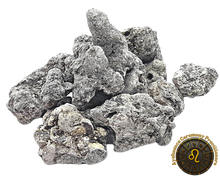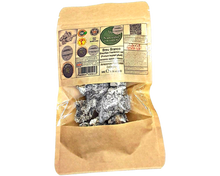

-
Nativilis Brazilian Frankincense - AMAZONIAN BREU BRANCO NATURAL INCENSE RESIN CHUNKS - Protium heptaphyllum - Shamanic traditional healing practices accompanying prayer - cleansing energies - spiritual purification - sacred purposes - Ayahuasca ceremony practitioners – Copaiba
- Aroma - Rich, smoky and bitter
- Name: Brazilian Frankincense (Breu Branco)
- Botanical name: Protium heptaphyllum
- Part of Plant: : Resin
- Batch Number: AMO 035 - 002/062021
- Number of analysis: 113/21
- Cultivation: Wild
-
Country of Origin: Brazil
-
Major Compounds: Alpha-pinene, Alpha-thuyene, Limonene, Myrcene, Sabinene, Terpinolene, Paracymene, Alpha-phellandrene. (See the Certification of Analysys)
- Blends well with: Copaiba. Excellent base oil for any blend.
- CHEMICAL COMPOSITION AND APPLICATION
- The properties of the resin of breu-branco are similar to the resin produced by species of Boswellia found in India and Africa. The resin consists of a large number of monoterpenes, such as α-pyrene (10.5%), limonene (16.9%), α-phellandrene (16.7%) and terpinolene (28.5%). Due to its aromatic property, the resin is widely used in perfumes and toiletries as well as in soap manufacturing. The limonene, present in the resin of breu-branco, is a common component in fragrances and essences.
- Has an expressive antioxidant activity, which sequesters free radicals on the skin. It has a proven repellent effectiveness against bloodsucking mosquito, validating its use as a repellent. Due to its aromatic property breu branco resin is widely used in the cosmetic industry as a fragrance fixative and exfoliator. With anti-septic and exfoliant properties; for a dry and oily skin.
- The major constituents are 3-carene, limonene, erpinolene, p-cymene-8-ol, α-tujeno and p-cymene.
-
Applications: - Psychological properties: antidepressant, anti-melancholic, neurosedative, refreshing, soothing, tranquilizing, relaxing, sedative, toning, balancing.
- Medicinal properties: antiseptic, analgesic, anti-inflammatory, antibacterial, antiviral, healing, cellular regenerator, carminative, antispasmodic, deodorant, anticonvulsant, antiasthmatic, decongestant.
- Indications: insomnia, snoring. nervous excitement, stress, anxiety, anguish, irritability, frustration. headaches, migraine, mood swings. cough, asthmatic bronchitis, colds, flu, sore throats; bug bite; acne, psoriasis, boils, ringworm, cold sores, dermatitis, eczema, rashes and skin infections; louse; muscle aches, rheumatism, tendinitis.
- Contraindications: Do not use in the first trimester of pregnancy. Do not overdose as it can cause intoxication in large quantities.

-
Nativilis Brazilian Frankincense - AMAZONIAN BREU BRANCO NATURAL INCENSE RESIN CHUNKS - Protium heptaphyllum -
-
Nativilis Brazilian Frankincense - AMAZONIAN BREU BRANCO NATURAL INCENSE RESIN CHUNKS -Protium heptaphyllum spiritual purification sacred purposes - Shamanic Ayahuasca ceremony practitioners - Copaiba
Nativilis Brasilianischer Weihrauch – AMAZONISCHE BREU BRANCO NATÜRLICHE WEIHRAUCHHARZSTÜCKE – Protium heptaphyllum – heilige Zwecke – Praktizierende der schamanischen Ayahuasca-Zeremonie – Copaiba
-
In the depths of the Amazonian rainforest, during the ancestral rituals of native Indians, the aromatic resin of a sacred tree has been used for centuries to open up the doors of memory. Being able to reach up to 20 meters, this majestic Amazonian tree secretes from its bark a beautifully aromatic white resin, by which the essential oil is obtained. The plant is scientifically known by the name of Protium Heptaphyllum, also commonly known as Breu Branco. Like Frankincense and Palo Santo, it belongs to the fragrant species of the Burseraceae family. As well as having a scent akin to that of Frankincense, yet fresher with a slight citrus fragrance, its chemical composition is also very similar, as are some of its properties. It comes as no surprise then, that the Protium Heptaphyllum is often dubbed the ‘Frankincense of Amazonia’.
-
Nativilis Brazilian Frankincense - AMAZONIAN BREU BRANCO NATURAL INCENSE RESIN CHUNKS - Protium heptaphyllum - is complex, deeply cleansing, aromatically sweet and up-lifting. Said to evoke creativity, it is also a grounding energetic sanitiser bringing calm and focus, thus facilitating meditation. A truly potent instrument in helping people connect to deeper levels of their soul, one can really see why the Amazonian's have been using Breu Branco in their rituals. The natives were also on to something else with this powerful plant; Breu Branco has been proved to be a very powerful healer.
-
Modern Medicinal Value Many studies have confirmed the myriad of healing properties this wondrous oil has to offer. The benefits one can reap from Nativilis Brazilian Frankincense - AMAZONIAN BREU BRANCO NATURAL INCENSE RESIN CHUNKS - Protium heptaphyllum - - Amazonian natural resin oil properties anti-inflammatory antiseptic analgesic soothing exfoliant for dry and oily skin - Copaiba are truly extraordinary.
-
When one contemplates the many benefits that Breu Branco possesses, one common denominator is revealed: the oil offers a variety of tremendous healing properties. For over 5000 years, many different cultures have used healing plant oils for a variety of health conditions. Reflecting on what has been discovered about Breu Branco- what the natives of the Amazon have known for centuries, it is perhaps time we reconnect with our roots and listen to what nature has to tell us. With modern day medicine being repeatedly recalled due to safety concerns and antimicrobial resistance becoming commonplace, increasingly more people are looking for natural alternatives. One thing many people are discovering works for them is aromatherapy. The benefits of essential oils are innumerable, and the healing properties are vastly abundant. Aromatherapy is becoming more and more popular and has yielded some amazing results. Join the revolution: let nature be your healer, and essential oils your medicine cabinet.
- Breu Branco incense comes from the resin of the Amazonian Proteum heptaphyllum tree. There are quite a few species of Proteum which produce resins and these other trees’ resins are used for incense too. In fact, Breu Claro, Breu Branco, and Copal Blanco, other resin incenses, all come from trees in the Burseraceae family. And if this family ever had a reunion, Palo Santo, Frankincense and Myrrh trees would be in attendance.
- Breu’s resin has some of the same therapeutic and aromatic properties as its cousins since it belongs to the same botanical family. Popularly, the tree is known as Breu, but if there is confusion as to who’s who at that family reunion, it would be with good cause. This tree is also known as Almécega, Amesla, Almécega Brava, Breuzinho, Witch Herb, White Pitch of the Field, Mescla, Brazilian Myrrh, and a few others. Identifying name tags would certainly be helpful at such a gathering.

- Shades of Gray - Breu resin is widely used by the Amazonian natives, generally in Brazil, in local folk medicine and in spiritual rituals. Depending on the variety of the tree, age, and other factors, the resin can present in a few shades: a dark, grayish color, almost black, and lighter whitish.
-
Old & New World Resins
According to some, the oldest known use of plant resins comes from the late Middle Stone Age in Southern Africa where they were used as adhesives to apply handles to stone tools. Much later, the mention of plant resins appeared in the writings of ancient Greece, Rome, and Egypt, especially frankincense and myrrh. These two were highly prized substances and required in some religious rites. Across the ocean in the New Americas, especially Meso and South America, it was the cousin counterparts, Breu and Copal, which were discovered and used. Both continue to be used in religious and sacred ceremonies today. -
Aromatic Properties of Breu Branco
Breu Branco resin has a fresh, clean, purifying scent with hints of lemon and pine. It is a commonly referred to as “Brazilian Frankincense”. Due to its aromatic property, the essential oil is widely used in perfumes an soaps. You can carry a piece of the resin or put it in drawers for a soothing scent that lasts. Yet the uses of Breuzinho go beyond smelling good and have been used in sacred practices. - Sacred Purpose - The scent of fragrant tree resins is used for spiritual and healing, aesthetic, and practical purposes. Breu Branco is no exception. Different species of copal have been burned in rituals in Mexico and Central America since the time of the ancient Aztecs and Mayans. In South America, other types of copal, resin from the Palo Santo tree, and other resins [such as Breu] and plant gums have been used in shamanic and traditional healing practices for accompanying prayer, smudging or cleansing energies, spiritual purification, and many other sacred purposes. Some say Breu is the incense resin of choice for practitioners of the Ayahuasca ceremony. They appreciate it for how it calms the soul and opens the way for creativity and deep exploration.
- The wafting smoke from the burning resin is said to repel mosquitos and evil spirits as well. Breu is said to raise the vibrancy of both the surrounding environment and the people who breathe in its aroma. Its smoke is especially recommended for times of changes, renovations, the start of new projects or completion of cycles.
- On the subtle plane, Breuzinho acts in the unconscious, in dreams and in the mystical region of the brain. The resin is also used as incense for removing negative energies and leaving the environment harmonious and healthy. Breuzinho smoke encourages a space for receptivity and reflection.
- Breu Branco is associated with a raft of medicinal uses, whether from the smoke of the burned resin, as an infusion of tree bark or as a syrup. For respiratory ailments, it has a cleansing and purging effect on the lungs, and it can be used in the treatment of colds, coughs, bronchitis, pulmonary pain, asthma, sinusitis, obstructions of the pathways and rhinitis. It is said to facilitate breathing and soothe cases of flu, laryngitis and act as an expectorant.
- As an analgesic, it is said to offer pain relief for twisting, bruising and banging the muscles. It is helpful for certain gastro-protective ailments such as easing stomach aches as well as headaches. As an anti-inflammatory, it eases arthritis, bursitis, and rheumatism. And as an antiseptic, it helps in cleaning and preventing infections.
- For cutaneous treatments, it is helpful in maintaining skin health by moisturizing, rejuvenating and repairing the skin. It treats skin injuries, itching, insect bites, and dermatitis. And some say Breu has hepato-protective properties, offering relief from liver malfunction.
-
Mindfulness and Emotional Support
For conditions associated with the mind, Breu is said to have a powerful effect on enhancing concentration, focus and organizing thoughts. It can be mentally revitalizing, easing restless states and stress, improving mental acuity and promoting calm and inner tranquility. It is said to sometimes be used as an antidepressant and a sedative. -
Helpful in balancing emotions, Breu helps strengthen the nervous system and reduces anxiety and tension, increases motivation, and boosts confidence. It is also said to stimulate creativity, is grounding and calming, raising the vibrancy of both the environment and the people who breathe in its aroma. As an incense, it is especially recommended for changes, renovations, the start of new projects or completion of cycles.
-
Precautionary Measures - Always test small quantity of oil, for possible allergic reaction. Do not take any essential oils internally without consultation from a qualified aromatherapy practitioner. Do not apply undiluted essential oils, absolutes, CO2s or other concentrated essences onto the skin . Use extreme caution when using oils with children and give children only the gentlest oils at extremely low doses. It is safest to consult a qualified aromatherapy practitioner before using essential oils with children. This information cannot be taken as medical information; neither can they engage our responsibility. For use of essential oils in a therapeutic direction, please visit a medical doctor or a certified aroma therapist.

-
Directions for use:
To burn your Breu Branco resin, you will need:
• A pea-sized piece of resin or a ½ tsp (about 2 grams) scoop of powdered resin.
• Charcoal tablet or “puck”.
• Censer (heat-resistant dish or plate).
• Lighter and tongs.
• A small amount of sand or ash.
Steps to burn Breu Branco resin:
• Gather a small mound of sand or ash in your censer.
• Light your charcoal tablet until it begins to spark. Place it down on the sand/ash mound (using tongs) and allow it to continue burning until it has burned enough for a thin layer of ash to cover the charcoal tablet.
• Place your Breu Branco resin on the charcoal tablet and allow it to burn.
- BE CAREFUL BURNING INCENSE ANYWHERE!
You can very easily burn yourself, your desk, carpet, curtains, lamp, forest, gerbil, etc. so always use the utmost care and respect when burning resin incense!

-
Best Use: 24 Months
- Shipping Weight:55g
- SKU: SKU-BREUBRANCO-RESIN-5060864590913
- Type: GTIN-13 - Number: 5060864590913
- Volume: 50gr - 1.76 oz. (US)
- Dimensions: Kraft Paper Window Stand Up Sealable Pouch with Zip Lock
- Size : (110 x 185mm)
-
Safety data: External use recommended. Internal use under guidance from
a qualified practitioner. Keep away from children and eyes. Avoid if pregnant. Store in a cool dry place.

ECOLOGY
This species is a tree that occurs in dry forests and is native to most of Brazil. The tree gives off an aromatic fragrance, has a dark red bark, and grows to 10 to 20 meters in height and can be 50 to 60 centimeters in diameter at the base. When a cut is made in the trunk the resin exudes, which has a white-green color and a very pleasant, fragrant aroma. When the resin comes in contact with air, it hardens. The resin is collected from the trunk and the ground manually, all year round, but especially in the summer. After it is collected it must be dried in the shade and then stored in sacks made of fibers, such as jute. Cuts on a tree to extract the resin can be first made when the tree is 8 to 10 years old. To harvest the resin of this species sustainably, it is recommended that each tree receives only 2 to 3 cuts per year.
Yields vary according to the process of extraction. The process of hydrodistillation yields 11% resin whereas steam distillation yields approximately 2.5% resin.
REFERENCES
Satyal, P. et all (2017): Chemical Composition, Enantiomeric Distribution, and Antifungal Activity of the Oleoresin Essential Oil of Protium amazonicum from Ecuador; Medicines (Basel). 2017 Sep 23;4(4). pii: E70. doi: 10.3390/medicines4040070. https://www.ncbi.nlm.nih.gov/pubmed/28946630 .
Pharmacognosy Reviews, The Chemistry and Pharmacology of the South America genus Protium Burm. f. (Burseraceae) January 2007,
Roth, Helga Lindorf, South American Medicinal Plants: Botany, Remedial Properties and General Use, 2002
Tesauro De Plantas Medicinales, Protium heptaphyllum (Aub) March, 2007
Oliveira et al, Latin American Journal of Pharmacy, Additional Evidence for the Antiinflammatory Properties of the Essential Oil of Protium heptaphyllum Resin in Mice and Rats. 2009
Banov, Daniel, Topical Pharmaceutical Bases for Treating Skin Conditions, 2016
Wherick A. Bernadi et al, Effects of topical application of essential oil from resin of almescar (Protium heptaphyllum (Aubl.) Marchand) in experimentally induced skin wounds in rats 2015
Chemical composition and acaricidal activity of the leaf and fruit essential oils of Protium heptaphyllum (Aubl.) Marchand (Burseraceae) 2007
Oliveira et al, Gastroprotective and anti-inflammatory effects of resin from Protium heptaphyllum in mice and rats 2004
Riberio et al A possible mechanism for anxiolytic and antidepressant effects of alpha-and beta-amyrin from Protium heptaphyllum (Aubl.) March 2007
Oliveira et al, Attenuation of capsaicin-induced acute and visceral nociceptive pain by alpha- and beta-amyrin, a triterpene mixture isolated from Protium heptaphyllum resin in mice. 2005
Gislei F. Aragão et al, Antiplatelet Activity of α.- and β.-Amyrin, Isomeric Mixture from Protium heptaphyllum, 2008
Oliveira et al, Protective effect of α- and β-amyrin, a triterpene mixture from Protium heptaphyllum (Aubl.) March. trunk wood resin, against acetaminopheninduced liver injury in mice, 2005
MDGC-MS analysis of essential oils from Protium heptaphyllum (Aubl.) and their antifungal activity against Candida specie 2016
Essential oil from the resin of Protium heptaphyllum: Chemical composition, cytotoxicity, antimicrobial activity, and antimutagenicity 2016
Almeida Santos et al, Antihyperglycemic and hypolipidemic effects of α, βamyrin, a triterpenoid mixture from Protium heptaphyllum in mice, 2012
https://www.ncbi.nlm.nih.gov/pmc/?term=breu+branco






























































